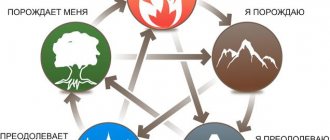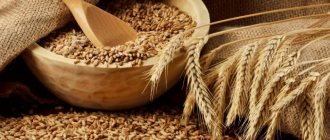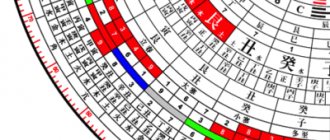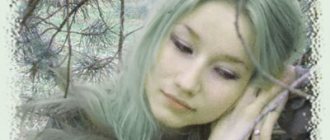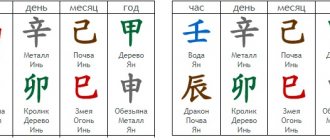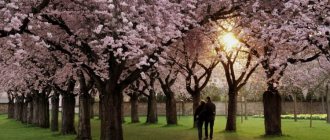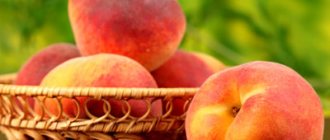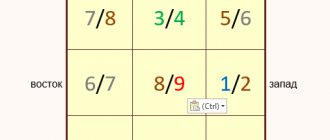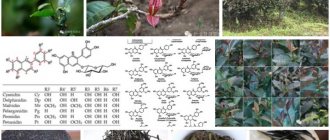What are Heavenly trunks and Earthly branches
Articles / Feng Shui and its concepts
Heavenly trunks (Chinese: 天干 tiāngān) are cyclic signs of the decimal cycle, reflect the cyclic movement of qi energy, the change in its quality over time.
| Sign | Pinyin | Transcription | Five elements | Five directions | Yin and Yang | |
| 1 | 甲 | jiǎ | Jia | 木 Tree | 东 East | 阳 Yang |
| 2 | 乙 | yǐ | AND | 阴 Yin | ||
| 3 | 丙 | bǐng | Bean | 火 Fire | South | 阳 Yang |
| 4 | 丁 | dīng | Dean | 阴 Yin | ||
| 5 | 戊 | wù | U | 土 Earth | 中 Center | 阳 Yang |
| 6 | 己 | jǐ | Ji | 阴 Yin | ||
| 7 | 庚 | gēng | Geng | Metal | West | 阳 Yang |
| 8 | 辛 | xīn | Xin | 阴 Yin | ||
| 9 | 壬 | ren | Ren | Water | North | 阳 Yang |
| 10 | 癸 | guǐ | Gui | 阴 Yin |
The earthly branches (地支 dìzhī) are the cyclic signs of the duodecimal cycle. The Earthly Branches are a manifestation of the will of Heaven on Earth.
| № | Sign | Pinyin | Transcription | Zodiac animals | Five elements |
| 1 | 子 | zǐ | Tzu | 鼠 Mouse | Water |
| 2 | 丑 | chǒu | Chow | 牛 Cow | 土 Earth |
| 3 | 寅 | yin | Yin | Tiger | 木 Tree |
| 4 | 卯 | mǎo | Mao | 兔Hare | |
| 5 | 辰 | chen | Chen | Dragon | 土 Earth |
| 6 | 巳 | sì | Sy | 蛇 Snake | 火 Fire |
| 7 | 午 | wǔ | U | 馬 Horse | |
| 8 | 未 | wèi | Wei | Sheep | 土 Earth |
| 9 | 申 | shēn | Shen | Monkey | Metal |
| 10 | 酉 | yǒu | YU | Rooster | |
| 11 | 戌 | xū | Xu | Dog | 土 Earth |
| 12 | 亥 | hài | Hai | 猪 Pig | Water |
The celestial trunks are used in combination with the signs of the duodecimal cycle. However, the origin of the system is not fully understood.
That is, one can ask a logical question: what are we talking about? What are pillars in objective space and what are branches on earth? Where is their starting point? How are the time cycles denoted by these cyclic signs expressed in subject-spatial terms?
If you take the Lo Shu diagram and look at the intricate movement of energy from number to number, you can see a certain principle.
This movement is expressed on a plane, but in volume it looks different:
If, according to the movement shown, we connect all the edges marked with the corresponding numbers, we get the following figure:
This is a depiction of the principle of the origin and development of life, which is equally applicable at all levels from the microcosm to the macrocosm.
The tetrahedron consists of two tetrahedrons - Male and Female, formed by connecting the vertices of Yin and Yang numbers.
In numerical values in this figure we have:
8 Vertices (angles) - hence 8 baguas and 8 main directions. This is where the concept of Heavenly Stems comes from . And there are 10 of them because another center (5) is added to the 8 corners, which is also represented by the energies of Yin and Yang, then 8 + 2 center = 10 trunks, forming the basis of the unfolding space.
12 Ribs - (connections between the vertices) are Earthly branches , since the ribs outline the directions of the Heavenly trunks and give them shape, so the Earth fulfills the will of Heaven, based on the original principle, the form expressed by the Earth appears.
24 Faces - the edges of two tetrahedrons intersect with each other, causing each of them to be divided in half, representing the alternation of Yin and Yang energies.
Cyclic signs are the intersection points of the Heavenly and Earthly principles in the “space” of the figure they form; they also simultaneously reflect the coordinate point and the state of energy at a given point relative to the general principle of movement.
The Chinese concept of round heaven and square earth (天圆地方) also reflects these principles. Circle - directions, unfolding space, square - formed edges or principles of unfolding, expressed in form.
In addition, the number 12 corresponds to 12 seasons on earth, the change of seasons is associated with the rotation of the Earth, so each season has its own direction and degree on the circumference. In addition, since the measure of all things is determined by Yin and Yang, each of the 12 seasons has its own Yin and Yang aspect, expressed in the 24 seasons displayed in the Chinese agricultural calendar .
| Ecliptic longitude | Translation | Chinese name | Approximate date in the Gregorian calendar |
| 315° | The beginning of spring | 立春 lichun | February 4-5 |
| 330° | Rainwater | 雨水 yushui | February 19-20 |
| 345° | It's time for the larvae to awaken | 驚蟄 (惊蛰) jingzhe | March 5-6 |
| 0° | The vernal equinox | 春分 chunfen | March 20-21 |
| 15° | Clear and light | 清明 qingming | April 4-5 |
| 30° | Bread showers | 穀雨 (谷雨) guiyu | April 20-21 |
| 45° | Early summer | 立夏 fox | May 5-6 |
| 60° | Small abundance | 小滿 (小满) xiaoman | May 21-22 |
| 75° | Earing corn | 芒種 (芒种) manzhong | June 5-6 |
| 90° | Summer solstice | 夏至 xiazhi | June 21-22 |
| 105° | Low heat | 小暑 xiaoshu | July 7-8 |
| 120° | Great heat | I will give it to you | July 23-24 |
| 135° | Beginning of autumn | 立秋 Liciu | August 7-8 |
| 150° | Stopping the heat | 處暑 (处暑) nonsense | August 23-24 |
| 165° | White Dew | 白露 bailu | September 7-8 |
| 180° | Autumn equinox | 秋分 qufen | September 23-24 |
| 195° | Cold dew | 寒露 hanlu | October 8-9 |
| 210° | Frost formation | 霜降 shuangjiang | October 23-24 |
| 225° | Early winter | 立冬 lidong | November 7-8 |
| 240° | Small snow | 小雪 xiaoxue | November 22-23 |
| 255° | Big snow | 大雪 daxue | December 7-8 |
| 270° | Winter solstice | 冬至 dongzhi | December 21-22 |
| 285° | Small cold | 小寒 xiaohan | January 5-6 |
| 300° | Big cold | 大寒dahan | January 20-21 |
Posted: 01/07/2014
Do you find this useful? Recommend to friends!
Leave a comment:
In order to leave a comment, please register, or log in if you have registered previously.
Hidden Heavenly Stems in the Bazi Map
Articles - Bazi Basics - Hidden Heavenly Stems in the MapWhen analyzing the Bazi map, a large number of parameters are taken into account. But the most important components are the Heavenly trunks and the Earthly branches.
The trunks of heaven are open
, that is, those located in the top line of the Bazi layout table.
And there are Heavenly trunks hidden in Earthly branches. They are called Hidden Heavenly Stems
. Abbreviated as SNA.
Pillars of Destiny
| hour | day | month | year | |
| Open Heavenly trunks | 甲 Yang Tree | 乙 Yin tree | 丙 Fire yang | 丁 Yin Fire |
| Earthly branches | 子 | 丑 | 寅 | 卯 |
| Hidden Heavenly Stems | 癸 Yin water | 己 Yin Earth | 甲 Yang Tree | 乙 Yin tree |
| 癸 | 丙 | |||
| 辛 | 戊 |
Each Earthly branch can have from one to three (in another school from two to four) Hidden Heavenly trunks.
A serious problem for beginners in learning Bazi can be the fact that two different and quite different approaches to this topic are used. That is, there are two sets of Hidden Heavenly Stems, one used in the classical school, the other in the school of Manfred Kubny. Advice for beginners
— choose one school at the initial stage of study.
So, elements - Heavenly trunks - are hidden in the Earthly branches. Their manifestation and influence on the map is different. There are Dominant Hidden trunks and secondary Hidden trunks.
Table. Hidden Heavenly trunks in the classical school.
| Earthly branch | Dominant SNA | Secondary SNA |
| Rat | 癸 | |
| 丑 Bull | 己 | 辛癸 |
| 寅Tiger | 甲 | 丙戊 |
| 卯Rabbit | 乙 | |
| Dragon | 戊 | 乙癸 |
| 巳 Snake | 丙 | 庚戊 |
| 午 Horse | 丁 | 己 |
| Goat | 己 | 丁乙 |
| 申 Monkey | 庚 | 戊壬 |
| Rooster | 辛 | |
| Dog | 戊 | 辛丁 |
| 亥 Pig | 壬 | 甲 |
In the table, the Dominant Heavenly Stems are highlighted in a separate column. We see that in the three branches 子Rat, 卯Rabbit and 酉Rooster, there is only one Hidden Trunk. These are branches with pure energy.
First of all, when analyzing, we look at the Dominant Hidden trunks; they show stronger character traits and qualities of a person.
In fact, the approach to initial map analysis can be greatly simplified. You just need to look at these eight hieroglyphs: Open trunks and Dominant hidden ones.
| hour | day | month | year | |
| Open Heavenly trunks | 甲 Yang Tree | 乙 Yin tree | 丙 Fire yang | 丁 Yin Fire |
| Earthly branches | ||||
| Hidden Heavenly Stems | 癸 Yin water | 己 Yin Earth | 甲 Yang Tree | 乙 Yin tree |
This is where the basic elements that work in the map are laid. And it is these trunks that will show the deities that we are analyzing. The same set of elements shows the main balance of energy in the map.
In the Bazi Classical School, for each Earthly branch there is only one, permanent Dominant Hidden Heavenly Stem. That is, for
For a Tiger it is always a trunk
甲
Yang Tree, for
a 巳
Snake it is always
丙
Yang Fire.
So here's what you need to know. To analyze the map, you need Open Heavenly Stems and Dominant Hidden Stems.
What are the rest of the Hidden Heavenly Stem doing? Shouldn't they be taken into account?
Need to. But they have a different function. As a human characteristic, the secondary Hidden Heavenly Stems work very weakly, we cannot take them into account. They show the hidden qualities of a person, one might even say some inclinations of certain character traits that have not developed or have not manifested themselves.
The main task of the secondary Hidden Heavenly Stems is to provide the root
open heavenly trunks. This is a very important feature that I will discuss in another article.
It is necessary to distinguish between two situations.
1. An element from the secondary Hidden Heavenly Stems can only be in the Earthly Branches
, then we can even ignore it and not take it into account in the analysis.
2. An element from the secondary Hidden Heavenly Stems comes to the surface
, that is, appears in Open Heavenly Stems. This is a completely different situation. Then this element becomes obvious, even sometimes strong. And in this case, he describes some fairly noticeable character trait. And we analyze this element very carefully; it can tell us a lot.
Let's look at the map.
| hour | day | month | year | |
| Open Heavenly trunks | 甲 Yang Tree | 乙 Yin tree | 丙 Fire yang | 丁 Yin Fire |
| Earthly branches | Rat _ | 丑 Bull | Tiger _ | 卯 Rabbit |
| Hidden Heavenly Stems | 癸 Yin water | 己 Yin Earth | 甲 Yang Tree | 乙 Yin tree |
| 癸 | 丙 | |||
| 辛 | 戊 |
丙
Yang fire is hidden in
the Tiger
.
This is a secondary Hidden Heavenly Stem, but there is also丙
Yang Fire in the Heavenly Stems. That is, Fire from the Tiger came to the surface. The fire in the Heavenly trunk of the month received its root in the Tiger. This is a bright, manifested and strong Fire - the element of Self-Expression. A person knows how to show himself, can speak well in public, has creative abilities, and is able to captivate people.
戊
The yang land in
Tiger
does not come to the surface. There is no Yang Land anywhere in the open Heavenly Stems. That is, it remains hidden. This is the element of Money - the deity's inclination towards wealth. In principle, it is not always bad if the element of money is found only in the Earthly branches. Then no one sees your money and no one encroaches on it)) But if we are talking, for example, about business, about attracting investments, about the desire to earn money, to invest it, then this character trait is not manifested in a person. Such a person does not strive to become a pure businessman, immersed in accounts and working out investment strategies. He is more interested in communicating with people, generating ideas, and he will gladly transfer boring accounting to someone else.
The same thing with the element of Power辛
Metal yin.
It is hidden in the Ox
and is only found in secondary SNAs and does not appear anywhere else in the map. If a person has a desire to command from time to time, it quickly disappears. And discipline is not his strongest character trait. And obviously you shouldn’t join the army or a rigid government structure. You won’t be able to realize yourself in these areas; you don’t have the right qualities.
That is, let's summarize. The elements in the Hidden Heavenly Stem may not work. This needs to be taken into account. Their manifestation depends on whether they come to the surface.
up
return to Articles section
What do the combinations of trunks and branches mean in the Chinese Feng Shui system?
@ Olga Kryuchkova
Kan Zhi is used to count time, and the hieroglyphs from which this word is composed are always found in the sectors of the Luopan compass. If there are 10 Heavenly Stems and 12 Earthly Branches, how many combinations of trunks and branches can be made? 120? Incorrect: Only 60 combinations because the 10 Stems are made up of two sets, the Yin and Yang versions of the 5 Elements. Therefore, when they need to be combined with the 12 Earthly Branches[1], it should be remembered that only Yin Trunks can be combined with Yin Branches (and only Yang Trunks with Yang Branches), resulting in only 60 combinations (12x5 = 60). Their names are composed of hieroglyphs indicating the names of Branches and Trunks. So, for example, the first combination is called chia tzu (that is, Heavenly Stem number 1 “chia” plus Earthly Branch I “tzu”). The common name for all 60 combinations in Chinese is chia tzu.
Let's look at the full range of trunk and branch combinations. Review Table 2.4, selecting combinations of one Trunk and one Branch. At their intersection is the combination number. You will clearly see why there are 60 and not 120 combinations. Half the combinations are not included because then they would mix yin and yang. Combinations can be made only by Yang Trunks and Yang Branches and only by Yin Trunks and Yin Branches. For example, at the intersection of Trunk number one "chia" and Branch I "tzu" you will see combination number one "chia tzu". This is a yang combination made up of Stem 1 of Branch I.
Combinations of trunks and branches. Continue reading the table, choosing combinations of one trunk and one branch. at their intersection is the combination number. you will clearly see why there are only 60 and not 1-20 combinations. Half the combinations are rejected because they mix yin and yang. Only Yin trunks and Yin branches and only Yang trunks and Yang branches are combined. Let's try to look at something more complicated. Find combination 52. Yes, that's Branch IV and Trunk number 2, or "and mao". What about the "ping chow" combination? There is nothing at their intersection... because "ping" is the yang trunk, and "chou" is the yin branch. This combination is not possible. Combinations are always either only Yin or only Yang!
Now let's look at other information related to this table. Take a look at the 53rd combination, for example. It is called "ping chen". What are its qualities? This is a combination of Yang Fire (ping) and Dragon (chen). Yeah, it turns out to be a Yang Fire Dragon. Incomprehensible Chinese words, when combined together, acquired a clear meaning. Or take combination 21 - “chia shen”. Her qualities are that of a Yang Wood Monkey. Now let's use the 60 combinations for practical purposes, namely to count years. We will see later that this method of counting is important in determining the "luck" of the house built that year and also the luck of its occupants.
